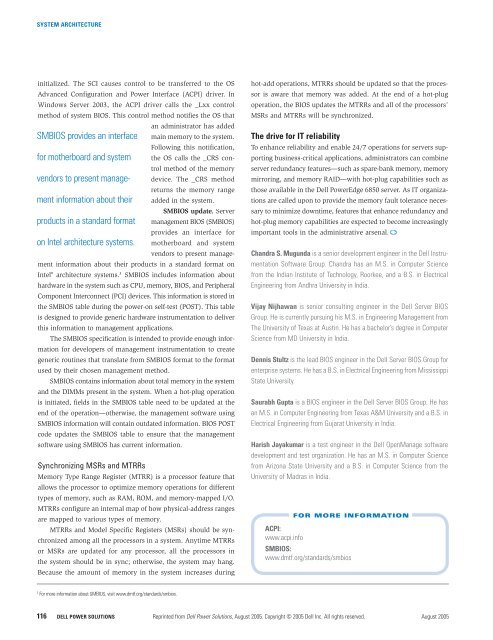POWER SOLUTIONS
POWER SOLUTIONS
POWER SOLUTIONS
Create successful ePaper yourself
Turn your PDF publications into a flip-book with our unique Google optimized e-Paper software.
SYSTEM ARCHITECTUREinitialized. The SCI causes control to be transferred to the OSAdvanced Configuration and Power Interface (ACPI) driver. InWindows Server 2003, the ACPI driver calls the _Lxx controlmethod of system BIOS. This control method notifies the OS thatSMBIOS provides an interfacefor motherboard and systemvendors to present managementinformation about theirproducts in a standard formaton Intel architecture systems.an administrator has addedmain memory to the system.Following this notification,the OS calls the _CRS controlmethod of the memorydevice. The _CRS methodreturns the memory rangeadded in the system.SMBIOS update. Servermanagement BIOS (SMBIOS)provides an interface formotherboard and systemvendors to present managementinformation about their products in a standard format onIntel ® architecture systems. 3 SMBIOS includes information abouthardware in the system such as CPU, memory, BIOS, and PeripheralComponent Interconnect (PCI) devices. This information is stored inthe SMBIOS table during the power-on self-test (POST). This tableis designed to provide generic hardware instrumentation to deliverthis information to management applications.The SMBIOS specification is intended to provide enough informationfor developers of management instrumentation to creategeneric routines that translate from SMBIOS format to the formatused by their chosen management method.SMBIOS contains information about total memory in the systemand the DIMMs present in the system. When a hot-plug operationis initiated, fields in the SMBIOS table need to be updated at theend of the operation—otherwise, the management software usingSMBIOS information will contain outdated information. BIOS POSTcode updates the SMBIOS table to ensure that the managementsoftware using SMBIOS has current information.Synchronizing MSRs and MTRRsMemory Type Range Register (MTRR) is a processor feature thatallows the processor to optimize memory operations for differenttypes of memory, such as RAM, ROM, and memory-mapped I/O.MTRRs configure an internal map of how physical-address rangesare mapped to various types of memory.MTRRs and Model Specific Registers (MSRs) should be synchronizedamong all the processors in a system. Anytime MTRRsor MSRs are updated for any processor, all the processors inthe system should be in sync; otherwise, the system may hang.Because the amount of memory in the system increases duringhot-add operations, MTRRs should be updated so that the processoris aware that memory was added. At the end of a hot-plugoperation, the BIOS updates the MTRRs and all of the processors’MSRs and MTRRs will be synchronized.The drive for IT reliabilityTo enhance reliability and enable 24/7 operations for servers supportingbusiness-critical applications, administrators can combineserver redundancy features—such as spare-bank memory, memorymirroring, and memory RAID—with hot-plug capabilities such asthose available in the Dell PowerEdge 6850 server. As IT organizationsare called upon to provide the memory fault tolerance necessaryto minimize downtime, features that enhance redundancy andhot-plug memory capabilities are expected to become increasinglyimportant tools in the administrative arsenal.Chandra S. Mugunda is a senior development engineer in the Dell InstrumentationSoftware Group. Chandra has an M.S. in Computer Sciencefrom the Indian Institute of Technology, Roorkee, and a B.S. in ElectricalEngineering from Andhra University in India.Vijay Nijhawan is senior consulting engineer in the Dell Server BIOSGroup. He is currently pursuing his M.S. in Engineering Management fromThe University of Texas at Austin. He has a bachelor’s degree in ComputerScience from MD University in India.Dennis Stultz is the lead BIOS engineer in the Dell Server BIOS Group forenterprise systems. He has a B.S. in Electrical Engineering from MississippiState University.Saurabh Gupta is a BIOS engineer in the Dell Server BIOS Group. He hasan M.S. in Computer Engineering from Texas A&M University and a B.S. inElectrical Engineering from Gujarat University in India.Harish Jayakumar is a test engineer in the Dell OpenManage softwaredevelopment and test organization. He has an M.S. in Computer Sciencefrom Arizona State University and a B.S. in Computer Science from theUniversity of Madras in India.FOR MORE INFORMATIONACPI:www.acpi.infoSMBIOS:www.dmtf.org/standards/smbios3For more information about SMBIOS, visit www.dmtf.org/standards/smbios.116DELL <strong>POWER</strong> <strong>SOLUTIONS</strong> Reprinted from Dell Power Solutions, August 2005. Copyright © 2005 Dell Inc. All rights reserved. August 2005








